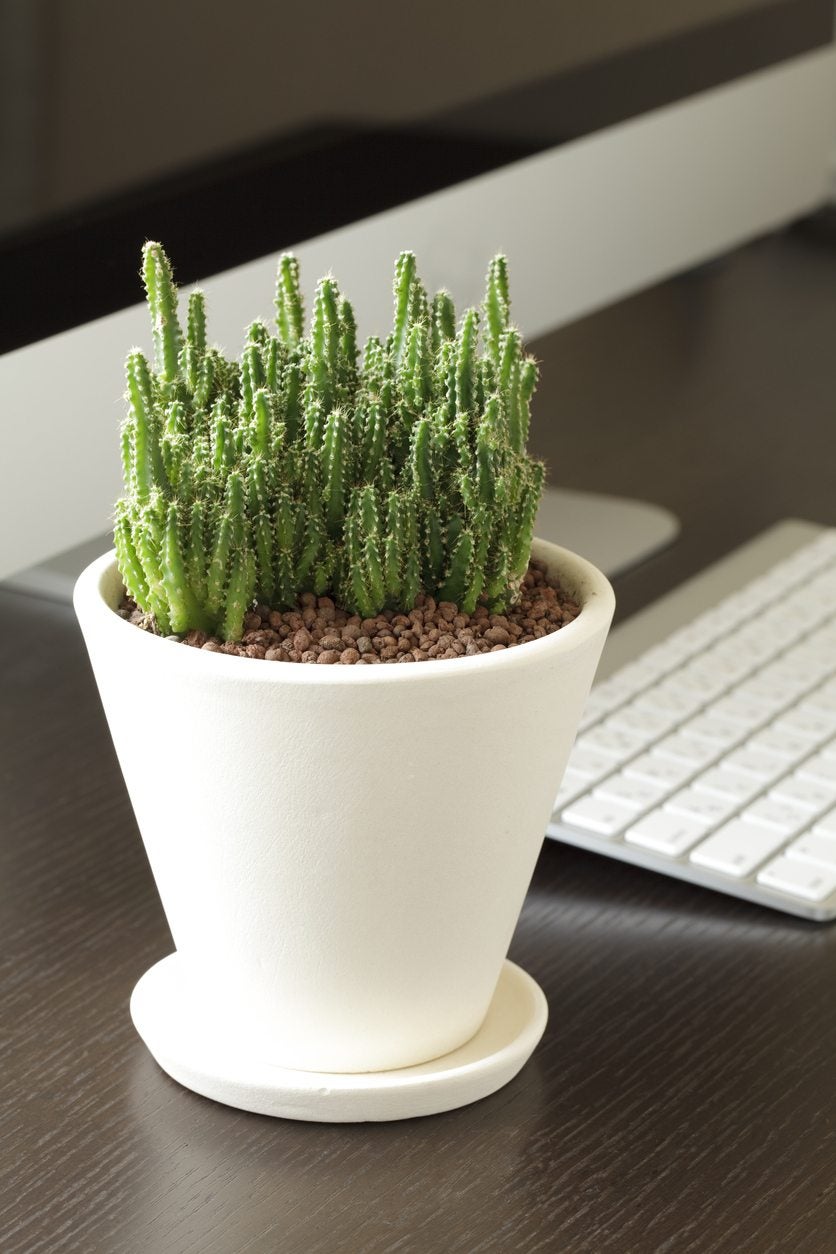Caring For Desk Plants: Learn How To Care For An Office Plant


A small plant on your desk makes your work day a little cheerier by bringing a bit of nature indoors. Office plants may even boost your creativity and make you feel more productive. As an added bonus, plants have been proven to improve indoor air quality. What’s not to like? Read on and learn how to care for an office plant.
Caring for Desk Plants
Office plant care is important and not as involved as one would think, provided you focus on the needs of the plant chosen. Various plants have different needs, so pay attention to watering, light, and other possible desk plant maintenance that may be required.
Watering
Improper watering–either too much or not enough– is usually to blame when office plant care goes awry. Water office plants slowly, using lukewarm water, until water trickles through the drainage hole, but only when the top of the soil feels dry to the touch. Never water if the soil still feels damp from the previous watering. Allow the plant to drain thoroughly and never allow the pot to stand in water. There are a couple of ways to accomplish this. Either take the plant to a sink and water it straight from the tap, then let it drain before returning it to the saucer. If you don’t have a sink, water the plant, allow it to drain for a few minutes, and then pour excess water out of the saucer.
Lighting
Some plants, such as cast iron plant, can get by with very little light. Others, including most types of cactus, require bright light. If your office plant needs light, put it near a window, but not too close because intense, hot sunlight will scorch most plants. If you don’t have a window, a fluorescent light near the plant is the next best thing.
Additional Care for Plants in the Office
Fertilize desk plants every other month during spring and summer using a general purpose, water-soluble fertilizer. Always water after fertilizing to prevent damage to the roots. Transplant desk plants when they get too large for their pots– usually every couple of years. Move the plant to a container just one size larger. It may seem like a good idea to move the plant to a larger pot, but all that damp potting mix can rot the roots and kill the plant. Place your plant away from air conditioners, heating vents, or drafty windows. Ask a friend or co-worker to take care of your plant if you’re sick or on vacation. Some plants can tolerate a certain amount of neglect, but too much may kill them.
Gardening tips, videos, info and more delivered right to your inbox!
Sign up for the Gardening Know How newsletter today and receive a free copy of our e-book "How to Grow Delicious Tomatoes".

A Credentialed Garden Writer, Mary H. Dyer was with Gardening Know How in the very beginning, publishing articles as early as 2007.
-
 Which Invasive Shrubs Should You Avoid Growing? Plus, Best Natives To Plant Instead
Which Invasive Shrubs Should You Avoid Growing? Plus, Best Natives To Plant InsteadCertain plants may look lovely but they can wreak havoc to local areas and native wildlife. Here are the key invasive shrubs to avoid – with recommendations on gorgeous native alternatives to try
-
 What Not To Plant With Tomatoes: 8 Bad Neighbors That Could Ruin Your Harvest
What Not To Plant With Tomatoes: 8 Bad Neighbors That Could Ruin Your HarvestNot all companion plants are beneficial – some can sabotage your tomatoes. Find out which ones to keep at a safe distance in the garden.
-
 8 Easy Care Houseplants That Live A Long Time
8 Easy Care Houseplants That Live A Long TimeClick here to learn about our 8 favorite low maintenance houseplants that can, with proper care, live a long time.
-
 How Often Should You Repot Plants?
How Often Should You Repot Plants?Escaping roots and shrinking leaves may mean your plant wants a new pot, but some like staying cramped and cozy.
-
 Orange Flowering Houseplant Varieties With Tropical Flair
Orange Flowering Houseplant Varieties With Tropical FlairClick here to learn about some cheerful orange-blooming houseplants you can try growing.
-
 Variegated Houseplants With Lovely Leaves
Variegated Houseplants With Lovely LeavesWhat are some of the best variegated houseplants to add to your collection? Click here to find out.
-
 Lovely, Lacy Indoor Foliage Plants
Lovely, Lacy Indoor Foliage PlantsClick here to learn about some houseplants with lacy foliage to add to your collection.
-
 Best Christmas Houseplants And Plants For Winter Holidays
Best Christmas Houseplants And Plants For Winter HolidaysClick here for an idea of the best houseplants to use for holiday décor for Christmas, Hanukkah, Kwanzaa, and New Year’s.
-
 Best Big Houseplants To Create An Indoor Oasis
Best Big Houseplants To Create An Indoor OasisIf you have the space you may want to grow some large houseplants. Here are some ideas.
-
 Relaxing Plants To Grow Indoors For A Calmer Mind
Relaxing Plants To Grow Indoors For A Calmer MindAre there houseplants that can help you to relax? Click here to find out.